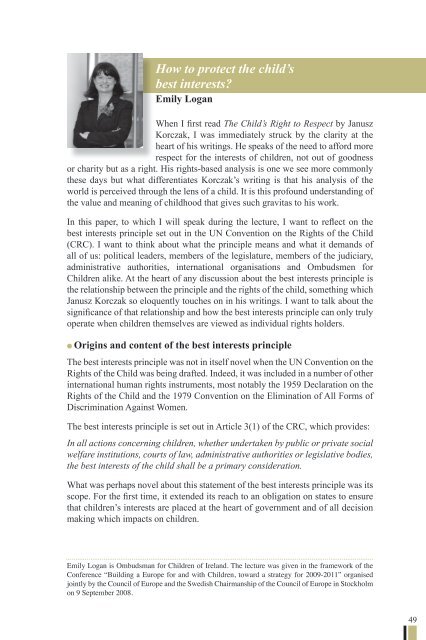Create successful ePaper yourself
Turn your PDF publications into a flip-book with our unique Google optimized e-Paper software.
How <strong>to</strong> protect the child’s<br />
best interests?<br />
Emily Logan<br />
When I first read <strong>The</strong> Child’s <strong>Right</strong> <strong>to</strong> <strong>Respect</strong> by <strong>Janusz</strong><br />
<strong>Korczak</strong>, I was immediately struck by the clarity at the<br />
heart of his writings. He speaks of the need <strong>to</strong> afford more<br />
respect for the interests of children, not out of goodness<br />
or charity but as a right. His rights-based analysis is one we see more commonly<br />
these days but what differentiates <strong>Korczak</strong>’s writing is that his analysis of the<br />
world is perceived through the lens of a child. It is this profound understanding of<br />
the value and meaning of childhood that gives such gravitas <strong>to</strong> his work.<br />
In this paper, <strong>to</strong> which I will speak during the lecture, I want <strong>to</strong> reflect on the<br />
best interests principle set out in the UN Convention on the <strong>Right</strong>s of the Child<br />
(CRC). I want <strong>to</strong> think about what the principle means and what it demands of<br />
all of us: political leaders, members of the legislature, members of the judiciary,<br />
administrative authorities, international organisations and Ombudsmen for<br />
Children alike. At the heart of any discussion about the best interests principle is<br />
the relationship between the principle and the rights of the child, something which<br />
<strong>Janusz</strong> <strong>Korczak</strong> so eloquently <strong>to</strong>uches on in his writings. I want <strong>to</strong> talk about the<br />
significance of that relationship and how the best interests principle can only truly<br />
operate when children themselves are viewed as individual rights holders.<br />
l Origins and content of the best interests principle<br />
<strong>The</strong> best interests principle was not in itself novel when the UN Convention on the<br />
<strong>Right</strong>s of the Child was being drafted. Indeed, it was included in a number of other<br />
international human rights instruments, most notably the 1959 Declaration on the<br />
<strong>Right</strong>s of the Child and the 1979 Convention on the Elimination of All Forms of<br />
Discrimination Against Women.<br />
<strong>The</strong> best interests principle is set out in Article 3(1) of the CRC, which provides:<br />
In all actions concerning children, whether undertaken by public or private social<br />
welfare institutions, courts of law, administrative authorities or legislative bodies,<br />
the best interests of the child shall be a primary consideration.<br />
What was perhaps novel about this statement of the best interests principle was its<br />
scope. For the first time, it extended its reach <strong>to</strong> an obligation on states <strong>to</strong> ensure<br />
that children’s interests are placed at the heart of government and of all decision<br />
making which impacts on children.<br />
Emily Logan is Ombudsman for Children of Ireland. <strong>The</strong> lecture was given in the framework of the<br />
Conference “Building a Europe for and with Children, <strong>to</strong>ward a strategy for 2009-2011” organised<br />
jointly by the Council of Europe and the Swedish Chairmanship of the Council of Europe in S<strong>to</strong>ckholm<br />
on 9 September 2008.<br />
49


